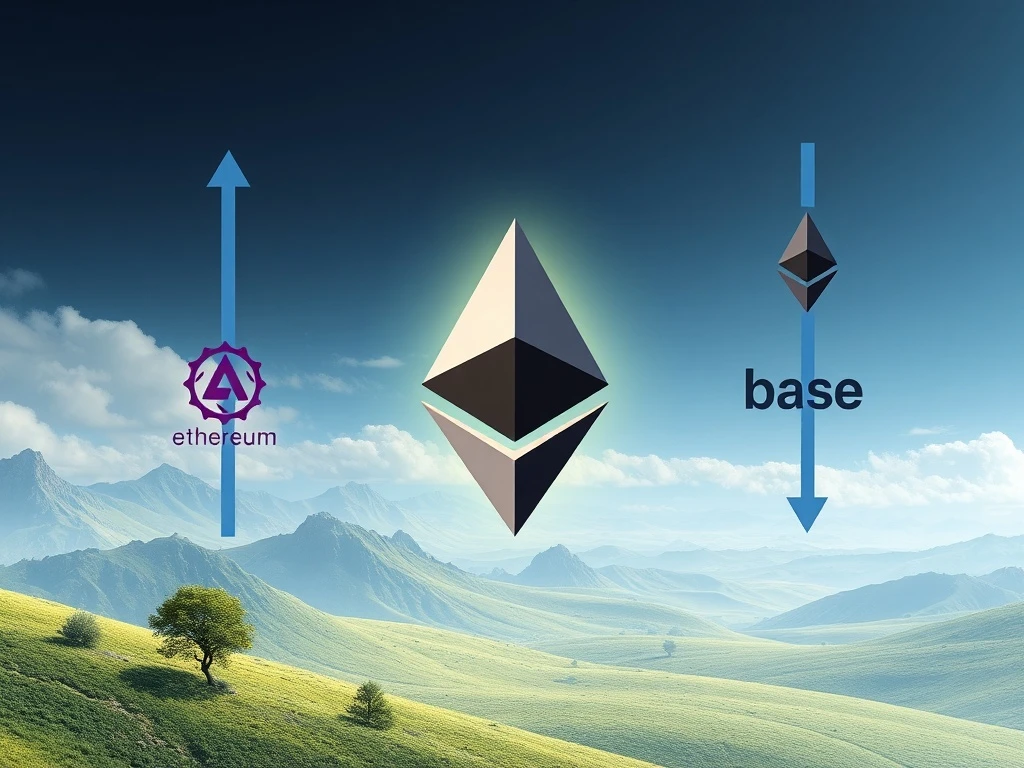Ethereum Transaction Count Soars: A Looming Challenge for Market Dominance

The cryptocurrency world constantly evolves. Notably, the Ethereum transaction count has recently shown impressive growth. This surge coincides with Ether’s (ETH) push toward the significant $5,000 milestone. However, this positive trend hides a critical challenge. Increased blockchain competition is actively eroding Ethereum’s valuable Ethereum market share and user engagement. This dynamic shift forces network stakeholders to reconsider their strategic approach.
Understanding the Ethereum Transaction Surge
Ethereum’s daily average transaction count is nearing all-time highs. On a recent Tuesday, Nansen reported over 1.7 million transactions. This demonstrates robust activity on the network. Such figures typically signal strong user adoption and increasing utility for the blockchain. Moreover, this growth aligns with a general bullish sentiment surrounding ETH prices.
Yet, a closer look reveals a complex picture. While Ethereum’s base layer sees high transaction volumes, other networks are processing even more. For instance, Ethereum Layer-2 networks like Arbitrum recorded over 3.4 million transactions. Base, another L2, saw an astounding 8.6 million transactions. Similarly, Aptos, a competing Layer-1 blockchain, hosted 3.8 million transactions on a recent Monday, according to The Tie. These comparisons highlight the intense competition for transaction volume.
The Ascent of Layer-2 Networks and Their Impact
The rise of Layer-2 networks represents a significant shift within the Ethereum ecosystem. These solutions, including Arbitrum and Base, aim to scale Ethereum by processing transactions off-chain. They then batch them back to the mainnet. This approach dramatically reduces transaction costs for users. Consequently, many users have migrated to these cheaper alternatives.
A pivotal development facilitating this shift was the Dencun upgrade. Launched in March 2024, this upgrade substantially lowered ETH network fees for Layer-2 networks. Previously, high fees on the Ethereum base layer, sometimes reaching $50 per transaction during congestion, deterred many users. The Dencun upgrade effectively incentivized users to embrace these more economical Layer-2 solutions. This strategic move benefits the broader Ethereum ecosystem by offloading traffic from the mainnet. It also, however, contributes to the erosion of direct revenue for the base layer.
Intensifying Blockchain Competition from Layer-1s
Beyond Layer-2s, a new generation of Layer-1 blockchains poses a direct threat. High-throughput networks like Solana and Sui are aggressively competing for user mindshare. They offer significantly lower transaction costs and faster processing speeds. This fierce blockchain competition challenges Ethereum’s once undisputed dominance as the leading smart contract platform.
These alternative Layer-1s present compelling value propositions. They often boast superior performance metrics compared to Ethereum’s base layer. For example, their ability to handle massive transaction volumes at minimal cost attracts developers and users seeking efficiency. As a result, they are actively siphoning users and projects away from Ethereum, directly impacting its Ethereum market share. This ongoing battle for supremacy underscores the dynamic nature of the crypto landscape.
Stagnant Active Addresses and Eroding Market Share
While the Ethereum transaction count rises, the number of active addresses tells a different story. Ethereum’s active addresses have remained relatively flat. They fluctuate within a range of 400,000 to 600,000 since 2018. Occasional spikes have pushed numbers above the 1 million mark, but these are not sustained. This stagnation contrasts sharply with the overall growth seen across the blockchain sector.
This data suggests a crucial trend: much of Ethereum’s potential traffic is now diverting. Users are choosing other blockchain networks, both Layer-1s and Layer-2s. This diversion directly erodes Ethereum’s market share. It also impacts protocol revenues. Network stakeholders must now confront these challenges. They are forced to reconsider the network’s long-term strategy. Is Zora turning Ethereum L2 Base into a Solana killer? This question highlights the evolving competitive landscape.
The Downward Trend in ETH Network Fees
The decline in ETH network fees has been steep since 2021-2022. This reduction is partly due to the Dencun upgrade, as discussed earlier. Lower fees are beneficial for users, making the network more accessible. However, they also reduce the revenue generated by the Ethereum protocol itself. This poses a financial challenge for the network’s sustainability and development efforts.
High fees were once a significant barrier to entry for many users and applications. Now, with lower costs, more activity shifts to Layer-2s. This movement impacts the base layer’s profitability. The network must balance user affordability with its own financial health. This delicate balance is crucial for maintaining its long-term viability and competitiveness.
Strategic Reconsideration: Ethereum’s Evolving Roadmap
Ethereum, once the undisputed leader, faces growing pressure. This pressure comes from both within its ecosystem and from external players. The network’s stakeholders must now adapt to these changes. They are actively reconsidering Ethereum’s scaling and execution roadmap. This adaptation is vital for maintaining its relevance and securing its Ethereum market share.
Polygon Labs CEO Marc Boiron recently offered a cautionary perspective. He suggested that directly competing with newer Layer-1 networks on performance metrics might prove ‘dangerous’ for Ethereum. Instead, Ethereum’s strength lies in its decentralization, security, and robust developer community. The focus may shift towards enhancing these core values rather than engaging in a throughput arms race. This strategic pivot is crucial for Ethereum’s future success.
The Future Landscape: Navigating Blockchain Competition
The rising Ethereum transaction count is undoubtedly positive. However, it cannot mask the significant challenges posed by fierce blockchain competition. The erosion of Ethereum market share by powerful Layer-2 networks and innovative Layer-1s is a critical concern. Furthermore, the decline in ETH network fees, while beneficial for users, impacts the protocol’s revenue streams.
Ethereum must continue to evolve. Its roadmap focuses on scalability through a rollup-centric approach. This strategy aims to leverage the strengths of Layer-2s while maintaining the security of the mainnet. Ultimately, Ethereum’s future success hinges on its ability to adapt. It must balance decentralization and security with the growing demand for efficiency and lower costs. This ongoing adaptation will define its position in the competitive blockchain landscape.









